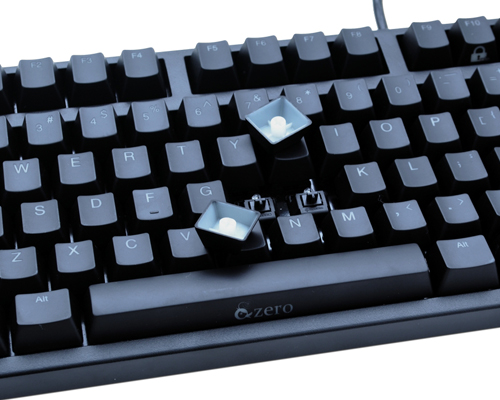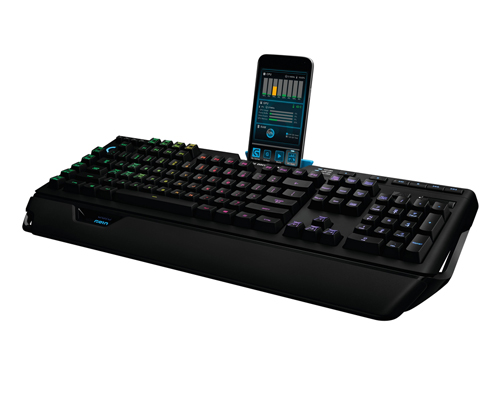Every serious PC gamer will rave about their favourite keyboard – and 99 times out of 100 that’s going to be a mechanical unit. There’s a reason that these old-school devices are the perfect companion for a modern gaming rig: they provide a solid, snappy and consistent typing action, the best speed and the most features.
The key to every top-quality keyboard is the mechanical switch under each button. Typically, this isn’t a simple situation – several companies make different switches, and they’ve got game-changing attributes.
We’ve taken a deep dive into the switches that form the bulk of the mechanical keyboards out there today – and explained the differences, too.
How Mechanical Keyboards Work
All mechanical keyboards work in broadly the same way: every key has a switch and a spring beneath the surface, with button-presses registered when the keys are pressed down.
Directly beneath the key is a component called the stem, which connects the key to the spring. When the key is pressed, the stem slides down, compressing the spring and registering a keypress. That’s not the only important bit, though: sliders and metal leaves can be used to interrupt or add texture to the downward motion of each key, which can provide the tactile bump that many people prefer on their old-school, traditional keyboards – something that’s not found on units without a mechanical design.
Tiny differences in these components give different mechanical switches a varied feel beneath the fingers. Some switches will deliver a smooth motion – referred to as a linear keystroke – while others will have a noticeable bump in the middle of the action.
Those keys are known as tactile, because they’ve got that extra physical feedback. The third main type of button derives from tactile, and is called clicky – because that bump in the middle of the stroke is accompanied by the loud clack that many still associate with mechanical keyboards.
Cherry MX On Top
There’s been a lot of movement in the mechanical keyboard market recently, but Cherry MX is still the dominant force in this department – and for good reason.
The German company produces a range of high-quality mechanical switches with different attributes. The firm’s switches are named after colours, which can be seen if you take the cap off each key and look at the mechanism beneath. Each switch appeals to different kinds of gamer – and so many companies produce their keyboards with multiple colours. The Corsair K70, for instance, is available with Red, Brown and Blue hardware in different models.
Cherry MX produces two linear switches: Red and Black. The former is light, requiring just 45g of force to register a keypress, while the latter needs a 60g push – so it feels heavier. Both of these linear switches don’t have any sort of bump during their action, and both are quiet – ideal if you don’t like the loud noises produced by many mechanical keyboards.
One of the best Cherry MX Red keyboards is the Asus ROG Claymore, which costs £199.99 an delivers an incredible set of features alongside those keys: RGB LEDs beneath each button, N-Key rollover, programmable macros on every key and a 1000Hz polling rate. It’s even got a detachable keypad that can be used for more macro recording.

And, if you’re after a Cherry MX Black unit, look no further than the Ducky Zero SZ, which includes nine backlighting modes and adjustable polling rates for £84.95.
Cherry MX’s other two main switches use more conventional tactile mechanisms. The Brown switches require a 45g force to register a press – the same as the Red switches – but their tactile bump means they still feel heavier. They’re firm, fast and quiet, and they’re a good middle ground if you’re after the feedback of a mechanical keyboard without the sheer weight sometimes associated with these peripherals.

The Cherry MX Brown switch is found inside the FNATIC Rush Pro, which is a no-frills gaming keyboard that costs a tempting £69.95 and has a concentration on speed and reliability. Despite that, and despite its low price, it still comes with backlighting, a wrist-rest and USB passthrough.
The Cherry MX Blue switch is a heavy-duty bit of hardware that requires 60g of force and has a hefty tactile bump in the middle of its downward action. It’s the loudest switch that Cherry makes, too. If you’re after a heavy, hardcore gaming keyboard, take a look at the Corsair STRAFE, which combines CherryMX Blue switches with multi-colour lighting, keycaps for FPS and MOBA gaming and fully programmable buttons.
In-House Hardware
The biggest change in the mechanical keyboard market is coming from some of the gaming world’s biggest companies. Firms like Razer, SteelSeries and Cooler Master are abandoning CherryMX and building their own mechanical switches instead.
Razer has produced two kinds of switches in collaboration with China-based Kailh, and they’re found inside the firm’s Blackwidow keyboards – devices like the £159.95 Blackwidow Chroma, which includes Razer’s switches alongside RGB backlighting and dedicated macro keys.
Razer’s Green switch is a tactile, heavy switch with a 55g force requirement and an 80-million keystroke lifespan – thirty million more than most Cherry MX switches. It’s fast, striking a keen balance between speed and solid feedback.
The other Razer-made switch is the Orange. This is quieter and smoother, with a barely-noticeable bump and a middling amount of weight.
Razer isn’t the only company to work with Kailh to build new mechanical switches. SteelSeries partnered with that company to build the QS1 switch, which is found in the Apex M800. It’s a light switch designed for speed, with a 45g force requirement and a 3mm travel distance – one millimetre less than many rivals. It’s also quieter than most mechanical switches.
The other big player is Logitech, which has built its Romer-G switch in partnership with Japanese firm Omron. It’s available in flagship products like the G910 Orion Spectrum, which serves up RGB lighting, smartphone integration and dedicated macro keys, which make it one of the most feature-packed gaming keyboards on the market.

The Romer-G switch is designed to be lighter, faster and quieter than traditional mechanical switches, with 45g of actuation force required and a relatively shallow actuation point and travel distance of 1.5mm and 3mm respectively. That does make the keys feel soft, comfortable and light, and there’s no denying the Romer-G switches speed – but purists may prefer the firmer, deeper typing of a Cherry MX switch.
Mechanical Alternatives
Mechanical keyboards are the best for gaming, but these levels of quality come with a high price. If that’s too much for you, then there are plenty of good alternatives – and most of these use membrane and rubber dome mechanisms.
These devices work with a simpler mechanism than most mechanical units. There’s either a membrane beneath the entire keyboard or a rubber dome beneath each individual key, and pressing a button pushes down these bits of plastic to complete a circuit on a PCB below. Once that circuit is complete, a keystroke is registered.
The simpler construction means that these keyboards are cheaper than mechanical units, but that also means that each key has to be completely depressed for a button-press to register, which means that these devices don’t have the nuance and tactile feel found on many mechanical devices.
Membrane keyboards tend to be mid-range units that are far more affordable than mechanical devices. Take the Cougar 500K, which costs £59.99 – its membrane hardware is paired with a palm-rest, macro keys, anti-ghosting and smart illumination settings.
The last kind of switch found in gaming keyboards, scissor, is also the cheapest. It’s a simple design, with each key sitting on a couple of anchors that push down and register a keystroke when the button is pressed. These units tend to be shallow and quiet, which makes them good for fast typing – but they lack the solid feel and long lifespan of mechanical units.
One of the best scissor keyboards around is the Cougar Vantar, which costs £28.99 and has anti-ghosting, media controls and LEDs with eight different colours.

Conclusion
There’s no question about it: mechanical switches are best for gaming, and there’s plenty of choice when it comes to buying, with different switches providing a vastly varied experience – so there’s little excuse for not boosting your gaming with Overclockers UK’s huge range of mechanical masterpieces.
